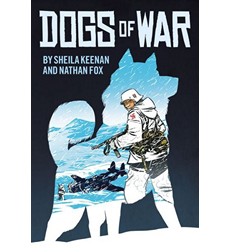A Q & A With Children’s Author Sheila Keenan
Sheila Keenan, author of a new graphic novel for kids, called Dogs of War, says she tries not to think too much about classroom policies when she writes.
“Good storytelling is good storytelling,” says Keenan.
Her latest work is about the relationships between soldiers and dogs during World War I. World War II and the Vietnam War. It’s fiction, but she did a lot of research to make sure it was historically accurate.
Keenan sat down with StateImpact Florida earlier this year to talk about graphic novels, libraries, and how the Common Core State Standards influence her writing.
Q: How does the way that literature gets taught in schools influence how you think about the way you’re writing for children?
A: To be honest, I don’t think of that first. I’m really thinking about storytelling first because I believe that kids aren’t any different from adults as readers. We want to read good stories.
I think one of the added benefits of graphic novels—at least what I hear from librarians—is that they’re flying off the shelves. Kids really like them. I think it’s the appeal of the visuals first—even though that’s of course so hard to say as a writer. But nonetheless, kids live in a far more visually integrated world now than ever. I think graphic novels appeal to them because of that.
But for kids who are struggling as readers, or don’t see themselves as good readers, a graphic novel is an awesome entry point. They can just jump right into the story. Reading a graphic novel, because its sequential, it is modeling the reading process for someone who is not as adept at literacy as someone else. It’s a great thing for them.Q: The Common Core State Standards have refocused the conversation about text complexity, nonfiction stories and other aspects of reading. As a writer for children, how much do you think about those things?
A: It’s all about the storytelling. What I think about is: am I being clear?
My book is historical fiction, however I did an enormous amount of research. All of the details in it, the world from which the story comes, is completely authentic and accurate.
I have to think to myself: am I being age appropriate in the way I’m presenting the violence and conflicts—and just how complicated war is?
Which is one of the reasons I decided to use the relationship between a soldier and a dog in each of these stories. That’s a relationship kids can relate to because they love animals. It was a good starting place for me to use an uncomplicated idea—I love my dog—and go to a complicated story. This is a war story.
The Common Core is bringing to the forefront ideas that are important for books like mine. I think it straddles some of the intents of Common Core in a way kids really like because a lot of kids like war stories, adventure stories, and it has all of that to it but it also has a good deal of information in it
Q: How did school affect your relationship to reading and to writing?
A: I loved school. I went to Catholic school and it was very strict. It didn’t even occur to me that not doing well was an option.
I always loved reading. My mother was a big reader and the library was a huge part of our lives. Even now living in New York City, being a writer, being a professional, my most important possession is my New York City Public Library card. Because when I was a kid, the library was everything to me. Growing up in a small town, the library took me to places I never could have gone.
I saw reading as something you just did. I didn’t associate it with school even though we read in school.
Q: What are some of the stories that stuck with you?
A: I loved Pippi Longstocking and I think it was because of the complete anarchy of that book. What could be better? There’s no parents. You’ve got a monkey, a trunk, you can do whatever you want. When I was really little, I think that’s why I liked the Cat in the Hat for the same reason. The idea that you could make mischief and be free is very compelling to a child.
Q: What do you wish policymakers understood about the way children read?
A: I just wish there were no rules about it. Let kids read whatever they want to read. Often I talk to kids and they’ll say “aw I have to read 16 pages tonight.” I’m like, who reads a book by 16 pages? Nobody. The joy of reading has to come first.


